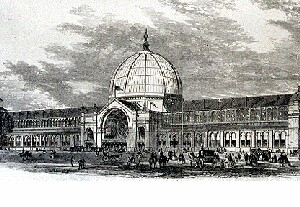|
1 |
 Copyright: Illustrierter Katalog, Leipzig 1864, Bd. 2, S. 181 |
|
1 |
 Copyright: Illustrierter Katalog, Leipzig 1864, Bd. 2, S. 181 |
Even after the opening – as is the case with most World Exhibitions – the building work was nowhere near complete, and the exhibits were far from all being in their rightful positions. To begin with, the Royal Commissioners had given the exhibitors a free hand to organise the space allocated to them. However, when the press complained about the monstrous exhibits and over-ornate architecture, the Commissioners were forced to pay for corrective work. It was no longer possible to remove a wall that the French had built in order to gain more exhibition space and to separate themselves from the nave. The wall thus became a symbol of the nationalist contest between the industrial states for superiority in the markets.
Unfortunately, no consistent classification system was developed for the organisation of the exhibits. Even the hefty catalogues were unable to help the knowledge-hungry visitors, as they failed to follow any comprehensible classification criteria and, in addition, were disfigured and unnecessarily distended by advertising. It is true that the building was organised by nations. Thus, the western side of the nave was given over to the exhibits of Turkey, Greece, Brazil, Russia, Sweden, Denmark, Switzerland, Holland and Belgium. However, even these groups were repeatedly interrupted by mixed exhibitions of arts and crafts, jewellery and sculpture. The western transept had been earmarked for exhibits from Austria and Germany. Most of the German states appeared together as the German Customs Union. However, as there was little money for elegant arrangement of the products, the German section appeared to many critics to be frugal, and the exhibits had to impress their audience on the strength of their own merits.
A art exhibition had been added to the industrial fair following the example set by the Paris World Exhibition of 1855. The picture gallery in the main building, which was 350 metres long – a feature praised by the British press – equalled the length of the Grande Galerie in the Louvre in Paris. A cleverly designed lighting system using skylights and a sawtooth roof ensured glare-free illumination of the pictures. Needless to say, they were displayed according to nationality, in accordance with the desire of the Commission, in order to make obvious the contribution of each nation “to progress in the arts and to their present condition”. Thus each nation could select a founding father for its artistic traditions and demonstrate his influence up to the present day. In the British section, this role was given to William Hogarth, represented by 33 paintings, and to Joshua Reynolds and Thomas Gainsborough. From here, a line could be drawn to Constable, Wilkie and the Pre-Raphaelites, whose strengths lay in landscapes, portraits and genre painting.
In the side annexes of the exhibition building, visitors were offered machinery pure and unadulterated. The halls were simple wood and glass constructions, and the machines had no need of ornate décor or cooling fountains. Machines weighing as much as 35 tons were on display, in contrast to 1851, when none of the machines on display had weighed more than 9 tons. The steel industry, in particular, had undergone enormous innovative progress. Since the invention of the Bessemer process, which meant that steel could be produced faster and in larger quantities, the production quality of the boiler, bridge girder and cannon had been taken to new heights. Henry Bessemer’s patented process was made much of at the World Exhibition. Friedrich Krupp from Essen, however, did not have to rely on this form of propaganda - he had already set up his first Bessemer furnace a few weeks earlier.
| Year: 1862 | City: London | Country: Great Britain |
| Duration: 1st May - 1st November 1862 | ||